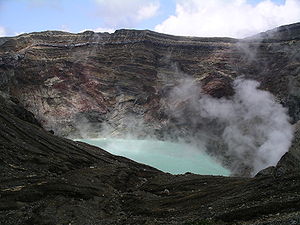Talk:Mount Aso
| This It is of interest to the following WikiProjects: | |||||||||||||||||||||||||||||||||||||||||
| |||||||||||||||||||||||||||||||||||||||||
Do you think
that maybe a link back to the article on supervolcanos may be appropiate, given the size of the caldera?
Mount Aso
This should be Mount Aso, not Aso so that it will conform to the format of the other mountains in the Category:Mountains of Japan.
The article needs to be bigger: found this article that could be folded into the existing one
“... Recession rates of two waterfalls, Ayugaeri Falls and Sugaru Falls, which are associated with the gorge formation of in the Tateno Canyon in the western part of the Aso caldera, are examined on the basis of the empirical equation after Hayakawa and Matsukura (2003). The waterfalls are postulated to have originated at a location out of the caldera as a waterfall which was formed around the front of the Akase lava erupted from the inside of the caldera. The initial waterfall receded about 2.8 km upstream forming the gorges to the present site of the confluence of the Shirakawa River and the Kurokawa River in the caldera. At the confluence, the waterfall bifurcated into two waterfalls which continued recession along the Shirakawa River and the Kurokawa River to the present locations of the Ayugaeri and Sugaru falls. The estimated recession rates from the equation are 0.086 m/y for Ayugaeri Falls and 0.14 m/y for Sugaru Falls. The calculated time taken for the recession of both waterfalls from the confluence to the present sites of the individual waterfalls is nearly equal: ca. 13,000 y, indicating that the bifurcation of the waterfall occurred about 13,000 years ago. Rough estimation suggests that the time for the initial waterfall to recede the distance of 2.8 km is 14,000-28,000 y. The total time of the waterfall recession from the start to the present location is thus 27,000-41,000 y, which is consistent with the age of the Akase lava flow (ca. 30,000 y).
Key words: waterfall, erosion rate, bedrock erosion, rock control, Aso volcano ... ” - Sparky 07:56, 6 March 2007 (UTC)
Proposal to replace Mount Aso Naka dake picture
As you can see the resolution and the clarity is much better. Igor Berger (talk) 22:46, 30 August 2009 (UTC)
- I'd agree with this, seems to be a vastly better image. (Note that I am currently Igor's mentor). With a bit of work in fact, it might qualify as a Featured Picture on Commons. Very good work IMO. Franamax (talk) 23:23, 30 August 2009 (UTC)
A bit confusing
I think if we make the Aso Caldera article the main one for geology and volcanic history as Aso Volcano and leave this one mainly relating to an important and populated geographical area given its weaknesses this would be consistent with what happens when caldera have lakes in them. ChaseKiwi (talk) 21:10, 24 September 2022 (UTC)
"although sources vary on the exact distance"
That seems strange. This isn't rocket science. Given the technology we've had for already many decades, why is it so hard to get a definitive measurement? Toddcs (talk) 12:17, 2 November 2023 (UTC)







